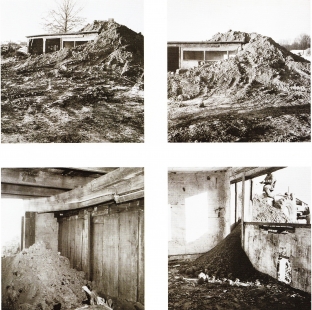
Philip Ursprung: Political Landscape. The Legacy of Earth Art
Pořadatel
Galerie VI PER
Místo konání
Vítkova 2, Praha 8
Start
mon 11.3.2019 19:00
Odkaz
http://www ...
Galerie VI PER
Místo konání
Vítkova 2, Praha 8
Start
mon 11.3.2019 19:00
Odkaz
http://www ...
Lectures
Publisher
Briefly lasting art movement Earth Art – a phenomenon that appeared from the late 1960s to the mid-1970s and includes artists such as Robert Smithson, Michael Heizer, Nancy Holt, Walter De Maria, and others – remains a source of inspiration to this day. Beginning with the interpretation of the work Partially Buried Woodshed (1970) by Robert Smithson, Philip Ursprung will focus on the relationship between art, architecture, territory, and economy. The mentioned artwork consisted of an old shed found on the university campus, which the artist had buried with earth until the roof collapsed. The process of building – that is, digging a hole and constructing a building – is reversed. The now-defunct building thus also reminds us that the earlier economy – specifically agriculture – was driven out of the newly constructed campus. The construction remains a ghost of the previous economy that cannot find rest. Agriculture is thus latently present in the spaces of higher education.
In the lecture, Ursprung will attempt to show that Earth Art as such is based on Smithson's encounter with architectural practice and planning. He will focus on Smithson's work and legacy under the unifying concept of “political landscapes” (Martin Warnke), above all on the relationship between power and artistic representation. He will also inquire what today architects, artists, designers, and theorists can learn from the historical phenomenon of Earth Art. Earth Art reflects the context and randomness of architectural practice and is an effective substitute for the missing theory of architecture.
Philip Ursprung serves as the dean of the School of Architecture at ETH Zurich, where he is also a professor of art and architectural history. He was born in Baltimore (USA), studied in Geneva, Vienna, and Berlin. He has taught at the Universität der Künste in Berlin, Columbia University New York, Universität Zürich, and at the Barcelona Institute of Architecture. His research focuses on the history of modern and contemporary art and architecture with an emphasis on the art of the 1960s and 1970s in North America and architecture in Europe after 1980. As a guest curator at the Canadian Centre for Architecture (CCA) in Montreal, he prepared the exhibition Herzog & de Meuron: Archeology of the Mind and edited its catalog Herzog & de Meuron: Natural History (Montreal, 2002). Among Ursprung's most recent books are Allan Kaprow, Robert Smithson, and the Limits to Art (Berkeley, 2013) and Representation of Labor / Performative Historiography (Santiago de Chile, 2018). A collection of texts by Gordon Matta-Clark, which he is preparing with Gwendolyn Owens, will be published by University of California Press.
In the lecture, Ursprung will attempt to show that Earth Art as such is based on Smithson's encounter with architectural practice and planning. He will focus on Smithson's work and legacy under the unifying concept of “political landscapes” (Martin Warnke), above all on the relationship between power and artistic representation. He will also inquire what today architects, artists, designers, and theorists can learn from the historical phenomenon of Earth Art. Earth Art reflects the context and randomness of architectural practice and is an effective substitute for the missing theory of architecture.
Philip Ursprung serves as the dean of the School of Architecture at ETH Zurich, where he is also a professor of art and architectural history. He was born in Baltimore (USA), studied in Geneva, Vienna, and Berlin. He has taught at the Universität der Künste in Berlin, Columbia University New York, Universität Zürich, and at the Barcelona Institute of Architecture. His research focuses on the history of modern and contemporary art and architecture with an emphasis on the art of the 1960s and 1970s in North America and architecture in Europe after 1980. As a guest curator at the Canadian Centre for Architecture (CCA) in Montreal, he prepared the exhibition Herzog & de Meuron: Archeology of the Mind and edited its catalog Herzog & de Meuron: Natural History (Montreal, 2002). Among Ursprung's most recent books are Allan Kaprow, Robert Smithson, and the Limits to Art (Berkeley, 2013) and Representation of Labor / Performative Historiography (Santiago de Chile, 2018). A collection of texts by Gordon Matta-Clark, which he is preparing with Gwendolyn Owens, will be published by University of California Press.
The English translation is powered by AI tool. Switch to Czech to view the original text source.

0 comments
add comment










